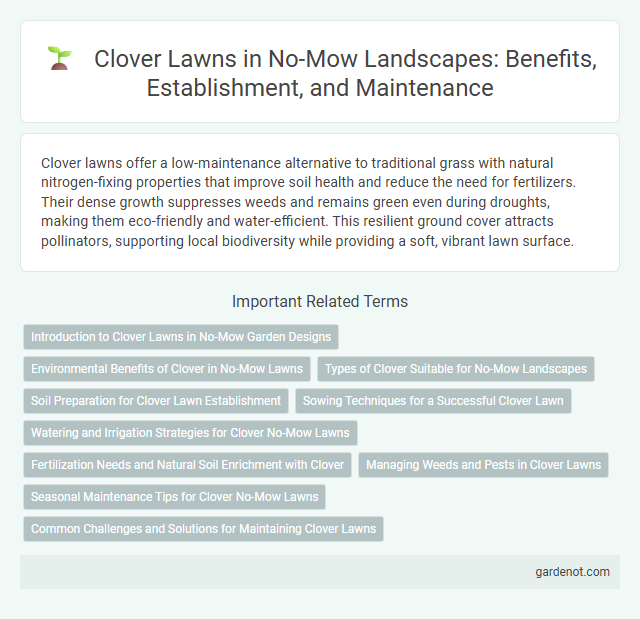Clover lawns offer a low-maintenance alternative to traditional grass with natural nitrogen-fixing properties that improve soil health and reduce the need for fertilizers. Their dense growth suppresses weeds and remains green even during droughts, making them eco-friendly and water-efficient. This resilient ground cover attracts pollinators, supporting local biodiversity while providing a soft, vibrant lawn surface.
Introduction to Clover Lawns in No-Mow Garden Designs
Clover lawns offer an eco-friendly alternative to traditional grass in no-mow garden designs, providing natural nitrogen fixation that enhances soil fertility. Their low-growing habit significantly reduces or eliminates the need for mowing, while supporting pollinators like bees and butterflies with abundant nectar. Integrating clover into lawns promotes drought tolerance, disease resistance, and a vibrant green cover throughout the growing season.
Environmental Benefits of Clover in No-Mow Lawns
Clover lawns enhance soil health by fixing atmospheric nitrogen, reducing the need for synthetic fertilizers and lowering greenhouse gas emissions. Their dense foliage suppresses weeds naturally, decreasing reliance on herbicides, while attracting pollinators like bees, supporting local biodiversity. Clover's deep root system improves soil aeration and water retention, contributing to drought resilience and reducing lawn maintenance.
Types of Clover Suitable for No-Mow Landscapes
Microclover (Trifolium repens var. 'Pirouette') and Dutch white clover (Trifolium repens) are the most popular types suited for no-mow lawns due to their low growth habit and nitrogen-fixing abilities. Microclover offers a finer texture and blends seamlessly with traditional grasses, while Dutch white clover provides durable ground cover and enhances soil fertility naturally. Both varieties require minimal maintenance, drought tolerance, and promote a lush, green appearance without frequent mowing.
Soil Preparation for Clover Lawn Establishment
Soil preparation for clover lawn establishment involves testing soil pH to ensure it ranges between 6.0 and 7.0, which promotes optimal nitrogen fixation and growth. Incorporating organic matter like compost enhances soil structure and moisture retention, supporting healthy root development for clover plants. Proper soil aeration and leveling reduce compaction, allowing clover seeds to germinate evenly and establish a dense, resilient lawn.
Sowing Techniques for a Successful Clover Lawn
Sowing clover lawn requires preparing well-drained soil with a fine, firm seedbed to ensure optimal seed-to-soil contact. Use a broadcast spreader for even seed distribution at a rate of 1 to 2 pounds per 1,000 square feet, followed by light raking or rolling to cover seeds without burying them deeply. Maintaining consistent moisture during germination and avoiding heavy foot traffic will improve establishment success and promote a lush, low-maintenance clover lawn.
Watering and Irrigation Strategies for Clover No-Mow Lawns
Clover no-mow lawns require less frequent watering than traditional grass, as their deep root systems enhance drought tolerance and reduce irrigation needs by up to 50%. Efficient irrigation strategies include applying water early in the morning to minimize evaporation and using drip irrigation or soaker hoses to provide targeted moisture directly to the soil. This approach conserves water, promotes healthy clover growth, and maintains a resilient, low-maintenance lawn.
Fertilization Needs and Natural Soil Enrichment with Clover
Clover lawns require significantly less fertilization compared to traditional grass as clover naturally fixes atmospheric nitrogen, enriching the soil and reducing the need for synthetic fertilizers. This nitrogen fixation process enhances soil fertility, promoting healthier plant growth and improving drought tolerance. Incorporating clover in no-mow lawns fosters a sustainable ecosystem by maintaining soil health and reducing chemical inputs.
Managing Weeds and Pests in Clover Lawns
Managing weeds and pests in clover lawns requires minimal chemical intervention due to clover's natural nitrogen-fixing properties and dense growth habit that suppresses weed emergence. Integrated pest management techniques, such as introducing beneficial insects like ladybugs and maintaining proper soil health, enhance pest control while preserving clover's resilience. Regular mowing and spot removal of invasive weeds further support a healthy, low-maintenance clover lawn ecosystem.
Seasonal Maintenance Tips for Clover No-Mow Lawns
Clover no-mow lawns require minimal seasonal maintenance, primarily involving annual overseeding in early spring to maintain thick coverage and outcompete weeds. Applying a balanced, low-nitrogen fertilizer in late spring supports healthy clover growth without encouraging excessive leafiness or mowing. Regularly monitoring soil pH and adjusting it to a slightly acidic range of 6.0 to 6.5 enhances nutrient availability and promotes resilient clover turf throughout the growing season.
Common Challenges and Solutions for Maintaining Clover Lawns
Clover lawns often face challenges such as weed invasion, patchy growth, and susceptibility to drought stress. To maintain a healthy clover lawn, regular soil testing ensures optimal pH levels between 6.0 and 7.0, while targeted overseeding addresses bare patches and promotes dense coverage. Proper irrigation strategies, such as deep watering during dry periods, improve drought tolerance and overall lawn resilience.
Clover lawn Infographic

 gardenot.com
gardenot.com